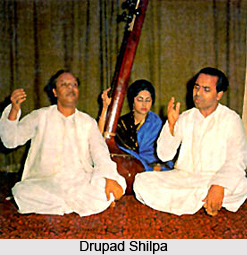 Dhrupad is one of the most ancient forms of North Indian Classical Music. The word Dhrupad is derived from two words, Dhruva meaning `structured, fixed or rigid` and Pada means `word or syllable`. The word Dhrupada or Dhruvapada therefore means `a composition in which the Padas or words are set in a definite structure or pattern`. The essence of Dhrupad music is primarily spiritual. The main attempt of Dhrupad is not so much to entertain as to stimulate feelings of peace and contemplation within the listener.
Dhrupad is one of the most ancient forms of North Indian Classical Music. The word Dhrupad is derived from two words, Dhruva meaning `structured, fixed or rigid` and Pada means `word or syllable`. The word Dhrupada or Dhruvapada therefore means `a composition in which the Padas or words are set in a definite structure or pattern`. The essence of Dhrupad music is primarily spiritual. The main attempt of Dhrupad is not so much to entertain as to stimulate feelings of peace and contemplation within the listener.
Origin of Dhrupad Music
It is a form of devotional music that traces its origin to the ancient text of Sama Veda. The Sama Veda was chanted with the help of melody and rhythm called Samgana. Slowly this developed into other vocal style called `Chhanda` and `Prabandha` with the initiation of verse and meter. The synthesis of these two elements led to the issuing of Dhrupad.
Theme of Dhrupad Music
Dhrupad compositions are full of religious, heroic and erotic themes and quite often are eulogies of gods and kings. Since the earliest Dhrupadas had invariably a devotional content, it is held that the Dhrupads originated in the religious-music of ancient times.
Structure of Dhrupad Music
Dhrupad music is mainly divided into two parts, the alaap and the dhrupad. A performance in dhrupad will start with a detailed alaap in a preferred Raaga. In this, the singer tries to evoke the mood, tone and spirit of the chosen Raaga elaborately and to its fullest extent and this is done without any musical accompaniment. Alaap forms the essence of dhrupad music. The contemplative character of the alaap is amplified by the prayerful manner in which the singer articulates these syllables in the lower, middle and upper registers. A Dhrupad alaap normally occupies the longest duration in a recital. The singer, many a time, begins with an inventive chant of the Omkara in the chosen Raaga. As the alaap follows no fixed text, the singer is free to use words like re de ti ri li na nom ta, collectively called nom tom, to emphasize and expatiate the notes.
The notes of the Raaga are explored and elaborated in the descending order until, gradually, the singer arrives at the lower register, at first, and then proceeds to the lower register of his voice (ati-mandra). This is followed by an ascent to the middle octave and the gathering of tempo, where improvisations are done, using swings of voice. These vocal modulations ultimately culminate with the singer touching the climactic high octave (taar sa) with incredible effect. The Jod or the Madhya alaap follows the free alaap. Here, there is a stable pulse which accentuates and adds rhythm to the alaap. Following this, the tempo quadruples and gives way to the drut-alaap, which is the same as the jhala section in instrumental music. Vocal modulations become compelling at this stage. Complex phrases and articulations are subject to heavy oscillations. A number of ornamentations are used to fancify the notes such as Gamakas and Meends. The drop from the high tempo to the middle one and, ultimately, to the Shadaj marks the end of the alaap section.
After the alaap comes the dhrupad or the song-text, also called bandish. The three components of this section are song-text, melody and rhythm, all of which are evenly accentuated. Rhythmic accompaniment is provided by a two-headed barrel-shaped drum called chautaal. The ten-beat sool taal and the dhammar taal of 14 beats are also used often. There are a total of four sections in the dhrupad- sthayi, antara, sanchari and abhog.
Instruments used in Dhrupad Music
Dhrupad was traditionally sung in accompaniment with Mridanga and Vind. Mridanga is a percussion instrument and was used to keep the beat, while Vind is an ancient string instrument and made singing more melodious. In ancient times no Dhrupad singing could be conceived without the accompaniment of Vind, but in the present day Vind has practically vanished as an accompanying instrument. Mridanga as an accompanying instrument has however not yet so completely vanished as the Vind though it is quite often replaced these days by Tabla.
Dhrupads have been undergoing a steady process of evolution and transformation right from the time of their emergence.




















